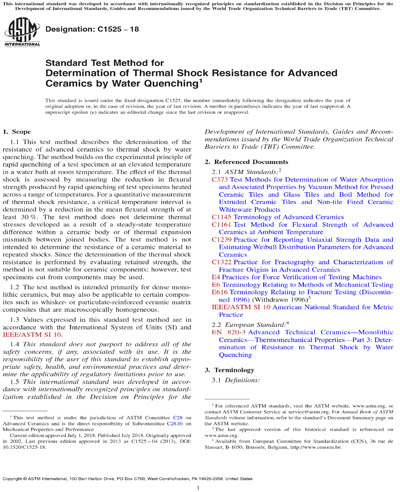Most recent
ASTM C1525-18
Standard Test Method for Determination of Thermal Shock Resistance for Advanced Ceramics by Water Quenching
1.1 This test method describes the determination of the resistance of advanced ceramics to thermal shock by water quenching. The method builds on the experimental principle of rapid quenching of a test specimen at an elevated temperature in a water bath at room temperature. The effect of the thermal shock is assessed by measuring the reduction in flexural strength produced by rapid quenching of test specimens heated across a range of temperatures. For a quantitative measurement of thermal shock resistance, a critical temperature interval is determined by a reduction in the mean flexural strength of at least 30 %. The test method does not determine thermal stresses developed as a result of a steady-state temperature difference within a ceramic body or of thermal expansion mismatch between joined bodies. The test method is not intended to determine the resistance of a ceramic material to repeated shocks. Since the determination of the thermal shock resistance is performed by evaluating retained strength, the method is not suitable for ceramic components; however, test specimens cut from components may be used.
1.2 The test method is intended primarily for dense monolithic ceramics, but may also be applicable to certain composites such as whisker- or particulate-reinforced ceramic matrix composites that are macroscopically homogeneous.
1.3 Values expressed in this standard test method are in accordance with the International System of Units (SI) and IEEE/ASTM SI 10.
1.4 This standard does not purport to address all of the safety concerns, if any, associated with its use. It is the responsibility of the user of this standard to establish appropriate safety, health, and environmental practices and determine the applicability of regulatory limitations prior to use.
1.5 This international standard was developed in accordance with internationally recognized principles on standardization established in the Decision on Principles for the Development of International Standards, Guides and Recommendations issued by the World Trade Organization Technical Barriers to Trade (TBT) Committee.
Content Provider
ASTM International [astm]






